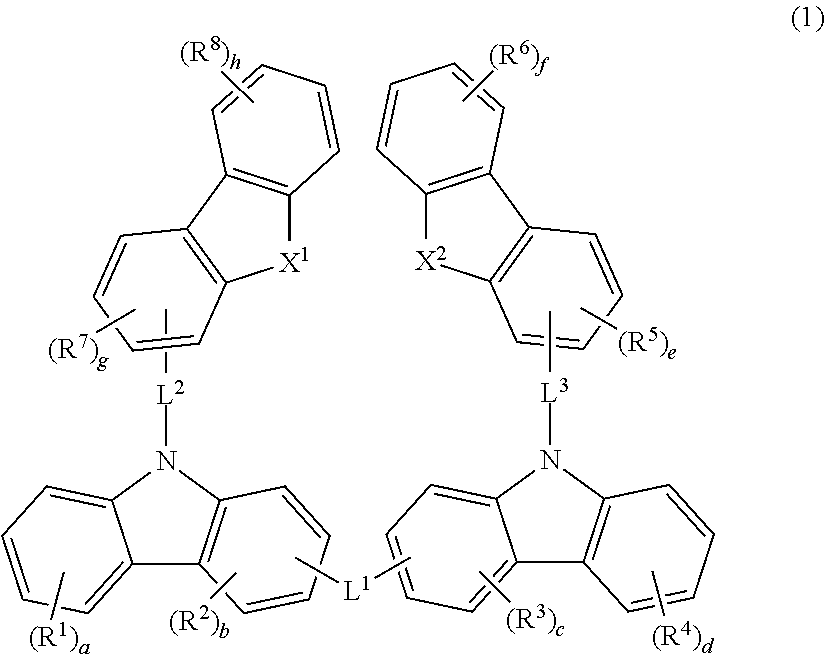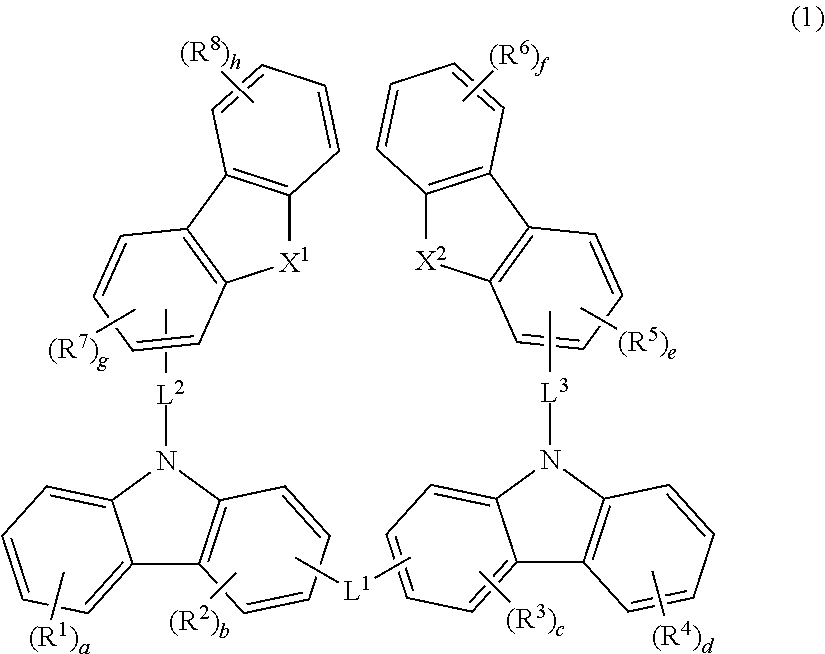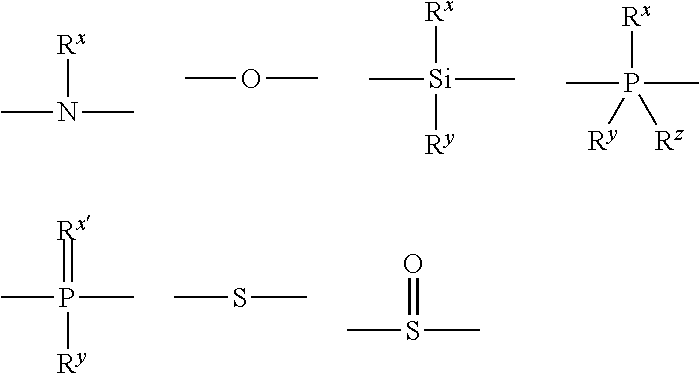Material for organic electroluminescent device and organic electroluminescent device using same
- Summary
- Abstract
- Description
- Claims
- Application Information
AI Technical Summary
Benefits of technology
Problems solved by technology
Method used
Image
Examples
synthetic example 1
Synthesis of Compound (1)
(1) Synthesis of Compound (1-a):
[0182]
[0183]A three neck flask was charged with 40.1 g (240 mmol) of carbazole, 49.4 g (200 mmol) of 2-bromodibenzofuran, 3.81 g (20 mmol) of copper iodide, 84.91 g (400 mmol) of potassium phosphate, 7.21 ml (60 mmol) of trans-1,2-diaminocyclohexane and 100 ml of 1,4-dioxane under nitrogen atmosphere, and the mixture was refluxed for 24 hours. After finishing the reaction, the mixture was cooled down to room temperature and then diluted with 400 ml of toluene. The inorganic salts and the like were removed by filtration under reduced pressure, and the filtrate was passed through a short column of silica gel, and then concentrated. It was washed with an ethyl acetate / methanol mixed solvent to obtain a white solid matter (compound (1-a)). Amount: 54.0 g and yield: 81%
(2) Synthesis of Compound (1-b):
[0184]
[0185]A Kjeldahl flask was charged with 26.7 g (80 mmol) of the compound (1-a) and 160 ml of N,N-dimethylformamide under air to...
synthetic example 2
Synthesis of Compound (3)
(1) Synthesis of Compound (3-a):
[0192]
[0193]A three neck flask was charged with 41.2 g (100 mmol) of the compound (1-b), 23.0 g (140 mmol) of mesityl boronic acid, 200 ml of a barium hydroxide 2M aqueous solution and 50 ml of 1,2-dimethoxyethane under nitrogen atmosphere, and 3.47 g (3 mmol) of teterakis(triphenylphosphine)palladium was added to the above mixed solution, followed by refluxing the solution for 8 hours.
[0194]After finishing the reaction, the solution was cooled down to room temperature, and then the solution was extracted with toluene by means of a separating funnel. The extract was dried on anhydrous magnesium sulfate, filtrated and concentrated, and then the concentrate was purified by silica gel chromatography (toluene:hexane=3:7). This was recrystallized from hexane to obtain a white solid matter (compound (3-a)). Amount: 15.3 g and yield: 34%
(2) Synthesis of Compound (3)
[0195]
[0196]A compound (3) was synthesized by the same method as in t...
synthetic example 3
Synthesis of Compound (36)
[0197]
[0198]A three neck flask was charged with 7.13 g (14.4 mmol) of the compound (3-c), 1.42 g (6 mmol) of 1,3-dibromobenzene, 12 ml of a sodium carbonate 2M aqueous solution, 12 ml of 1,2-dimethoxyethane and 12 ml of toluene under nitrogen atmosphere, and 0.35 g (0.3 mmol) of teterakis(triphenylphosphine)-palladium was added to the above mixed solution, followed by refluxing the solution for 8 hours.
[0199]After finishing the reaction, the solution was cooled down to room temperature, and then the sample solution was transferred into a separating funnel and extracted several times with toluene. The extract was dried on anhydrous magnesium sulfate, then filtrated and concentrated, and the concentrate was purified by silica gel chromatography to obtain a white solid matter (compound (36)). Amount: 4.3 g and yield: 73%.
[0200]The above compounds were subjected to measurement of FD / MS and identified by an agreement of the theoretical values of the molecular we...
PUM
 Login to View More
Login to View More Abstract
Description
Claims
Application Information
 Login to View More
Login to View More - R&D
- Intellectual Property
- Life Sciences
- Materials
- Tech Scout
- Unparalleled Data Quality
- Higher Quality Content
- 60% Fewer Hallucinations
Browse by: Latest US Patents, China's latest patents, Technical Efficacy Thesaurus, Application Domain, Technology Topic, Popular Technical Reports.
© 2025 PatSnap. All rights reserved.Legal|Privacy policy|Modern Slavery Act Transparency Statement|Sitemap|About US| Contact US: help@patsnap.com



